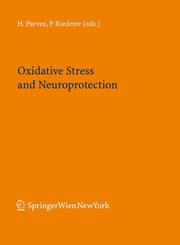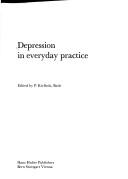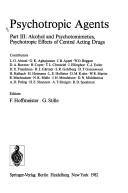| Listing 1 - 10 of 13 | << page >> |
Sort by
|
Book
ISBN: 3211820310 Year: 1988 Publisher: Wien : Springer,
Abstract | Keywords | Export | Availability | Bookmark
 Loading...
Loading...Choose an application
- Reference Manager
- EndNote
- RefWorks (Direct export to RefWorks)
Book
ISBN: 9155413412 Year: 1982 Publisher: Uppsala Uppsala university
Abstract | Keywords | Export | Availability | Bookmark
 Loading...
Loading...Choose an application
- Reference Manager
- EndNote
- RefWorks (Direct export to RefWorks)
Amines --- Monoamine Oxidase Inhibitors --- Hypothalamus --- chemical synthesis --- enzymology
Dissertation
ISBN: 9155414567 Year: 1983 Publisher: Stockholm Almqvist och Wiksell International
Abstract | Keywords | Export | Availability | Bookmark
 Loading...
Loading...Choose an application
- Reference Manager
- EndNote
- RefWorks (Direct export to RefWorks)
Monoamine Oxidase Inhibitors --- Neurons --- Phenethylamines --- Receptors, Serotonin --- pharmacology --- drug effects
Book
ISBN: 0387820094 Year: 1987 Publisher: Wien ; New York : Springer-Verlag,
Abstract | Keywords | Export | Availability | Bookmark
 Loading...
Loading...Choose an application
- Reference Manager
- EndNote
- RefWorks (Direct export to RefWorks)
Selegiline --- Parkinson's disease --- Antiparkinsonian agents --- Monoamine Oxidase Inhibitors --- Parkinson Disease --- Phenethylamines --- Testing --- Congresses. --- Chemotherapy --- Congresses. --- Testing --- Congresses. --- congresses. --- drug therapy --- congresses. --- therapeutic use --- congresses.
Book
ISBN: 3764327820 0817627820 9780817627829 Year: 1993 Publisher: Basel Birkhäuser Verlag
Abstract | Keywords | Export | Availability | Bookmark
 Loading...
Loading...Choose an application
- Reference Manager
- EndNote
- RefWorks (Direct export to RefWorks)
Pharmacology. Therapy --- Neuropathology --- Monoamine Oxidase Inhibitors --- Monoamine oxidase --- Nerve Degeneration --- Nervous System Diseases --- Nervous system --- Parkinson's disease --- Selegiline. --- Pharmacology. --- Therapeutic use. --- Inhibitors --- Drug effects. --- Drug therapy. --- Degeneration --- Chemotherapy. --- Monoamine Oxydase Inhibitors --- Selegiline --- drug effects --- drug therapy --- Chemotherapy --- therapeutic use --- Nerve Degeneration - drug effects --- Nervous System Diseases - drug therapy --- Nervous system - Degeneration - Chemotherapy --- Monoamine oxidase - Inhibitors - therapeutic use --- Parkinson's disease - Chemotherapy

ISBN: 1280727039 9786610727032 3211333282 3211333274 3709117364 3211333266 Year: 2006 Publisher: New York : Springer,
Abstract | Keywords | Export | Availability | Bookmark
 Loading...
Loading...Choose an application
- Reference Manager
- EndNote
- RefWorks (Direct export to RefWorks)
This book deals with basic and clinical aspects of monoamine oxidase (MAO) subtypes A and B highlighting its importance in neurological and psychiatric diseases. Consequently the therapeutic actions of MAO-A and -B inhibitors in Parkinson’s disease (PK) and depression are the focus of several chapters. As MAO is the basis of the development of the "oxidative stress hypothesis" of PD, several chapters are devoted to iron and iron-induced oxidative stress in various experimental studies and clinical conditions. Based on these findings, new compounds have been developed which not only block MAO, but are in addition, either inhibitors of acetylcholine esterase or have iron chelating properties. The aspect of "preclinical" and "clinical" neuro protection as well as MAO neuroprotection are additional topics covered in this book. MAO, iron and neuroprotection are seen in the framework of general anti Parkinson’s therapy with chapters on levodopa, dopaminergic receptor agonists and clinical issues.
Parkinson's disease. --- Monoamine oxidase --- Nervous system --- Oxidative stress. --- Inhibitors. --- Degeneration --- Molecular aspects. --- Oxidation-reduction reaction --- Stress (Physiology) --- Organs (Anatomy) --- Neurosciences --- Monoamine oxidase inhibitors --- Palsy, Shaking --- Paralysis agitans --- Parkinson disease --- Parkinsonism --- Shaking palsy --- Brain --- Extrapyramidal disorders --- Diseases --- Neurology. --- Medicine --- Neuropsychiatry --- Neurology .

ISBN: 3456801157 Year: 1974 Publisher: Bern Hans Huber
Abstract | Keywords | Export | Availability | Bookmark
 Loading...
Loading...Choose an application
- Reference Manager
- EndNote
- RefWorks (Direct export to RefWorks)
Depression, Mental --- Antidepressive Agents --- Depression --- Family Practice --- Family Practices --- Practice, Family --- Practices, Family --- Emotional Depression --- Depressive Symptoms --- Depression, Emotional --- Depressions --- Depressions, Emotional --- Depressive Symptom --- Emotional Depressions --- Symptom, Depressive --- Symptoms, Depressive --- Antidepressant Drugs --- Antidepressant --- Antidepressant Drug --- Antidepressants --- Antidepressive Agent --- Thymoanaleptic --- Thymoanaleptics --- Thymoleptic --- Thymoleptics --- Agent, Antidepressive --- Agents, Antidepressive --- Drug, Antidepressant --- Drugs, Antidepressant --- Monoamine Oxidase Inhibitors --- Congresses
Book
ISBN: 9780262363600 0262363607 9780262542241 0262542242 Year: 2021 Publisher: Cambridge, Massachusetts The MIT Press
Abstract | Keywords | Export | Availability | Bookmark
 Loading...
Loading...Choose an application
- Reference Manager
- EndNote
- RefWorks (Direct export to RefWorks)
"A complete and authoritative guide to the science of ketamine, the controversial yet current drug of choice for treating depression, a drug whose efficacy and impact is not yet well-established"--
Ketamine --- Antidepressive Agents --- Depressive Disorder --- Kétamine --- Antidépresseurs --- Dépression --- therapeutic use --- chemistry --- pharmacology --- drug therapy --- Emploi en thérapeutique. --- Chimie. --- Thérapeutique. --- Antidepressants --- Amines --- Anesthesia adjuvants --- Chlorobenzene --- Hexane --- Psychotropic drugs --- Depression, Mental --- Antidepressive agents --- Energizers, Psychic --- Psychic energizers --- 2-(2-Chlorophenyl)-2-(methylamino)cyclohexanone --- CI-581 --- Calipsol --- Calypsol --- Kalipsol --- Ketalar --- Ketamine Hydrochloride --- Ketanest --- Ketaset --- CI 581 --- CI581 --- Depression --- Monoamine Oxidase Inhibitors --- Antidepressant Drugs --- Antidepressant --- Antidepressant Drug --- Antidepressive Agent --- Thymoanaleptic --- Thymoanaleptics --- Thymoleptic --- Thymoleptics --- Agent, Antidepressive --- Agents, Antidepressive --- Drug, Antidepressant --- Drugs, Antidepressant --- Chemotherapy --- drug therapy.

ISBN: 3540098585 3642675409 3642675387 3540103007 3540103015 Year: 1981 Publisher: Berlin Springer
Abstract | Keywords | Export | Availability | Bookmark
 Loading...
Loading...Choose an application
- Reference Manager
- EndNote
- RefWorks (Direct export to RefWorks)
Antidepressive Agents. --- Psychotropic Drugs. --- Tranquilizing Agents. --- Tranquilizing Drugs --- Tranquilizing Effect --- Tranquilizing Effects --- Tranquillizing Agents --- Tranquillizing Drugs --- Ataractics --- Agents, Tranquilizing --- Agents, Tranquillizing --- Drugs, Tranquilizing --- Drugs, Tranquillizing --- Effect, Tranquilizing --- Effects, Tranquilizing --- Hypnotics and Sedatives --- Psychoactive Drugs --- Psychoactive Agents --- Psychopharmaceuticals --- Agents, Psychoactive --- Drugs, Psychoactive --- Drugs, Psychotropic --- Psychopharmacology --- Antidepressant Drugs --- Antidepressants --- Thymoanaleptics --- Thymoleptics --- Agents, Antidepressive --- Drugs, Antidepressant --- Depression --- Monoamine Oxidase Inhibitors --- Antidepressive agents --- Psychotropic drugs. --- Tranquilizing agents --- Antidepressive agents. --- Tranquilizing agents. --- Psychoactive Agent --- Psychoactive Drug --- Psychopharmaceutical --- Psychotropic Drug --- Agent, Psychoactive --- Drug, Psychoactive --- Drug, Psychotropic --- Antidepressant --- Antidepressant Drug --- Antidepressive Agent --- Thymoanaleptic --- Thymoleptic --- Agent, Antidepressive --- Drug, Antidepressant --- Antidepressive Agents --- Psychotropic Drugs --- Tranquilizing Agents
Book
Year: 2022 Publisher: Basel MDPI - Multidisciplinary Digital Publishing Institute
Abstract | Keywords | Export | Availability | Bookmark
 Loading...
Loading...Choose an application
- Reference Manager
- EndNote
- RefWorks (Direct export to RefWorks)
This book focuses of the neurotransmission phenomenon. By definition, neurotransmitters are chemicals that enable communication, i.e., the flow of nerve impulses between nerve cells or between nerve cells and muscles and glands. Recently, one can distinguish excitatory and inhibitory mediators, both of which are endo–exogenous compounds that control the function of the whole organism. From a chemical point of view, neurotransmitters belong to many different structural groups, such as amino acids (such as glycine), peptides (such as substance P, somatostatin), monoamines (such as noradrenaline or dopamine), purine derivatives (such as adenosine), gases (such as nitrogen, NO, carbon monoxide CO), and acetylcholine. From a medical point of view, disturbances in the concentration of neurotransmitters in the body result in the occurrence of mental disorders and diseases (such as depression, schizophrenia, Parkinson’s disease) and contribute to the occurrence of dementia (including Alzheimer’s disease), among other diseases. However, the problem is much wider. These disorders can lead to a number of cardiovascular diseases and can lead to the development of vascular diseases of the brain as well as in many other organs. Therefore, pharmacological intervention is a therapy that tries to interfere with regulatory processes year after year. Such treatments improve survival, reduce the frequency of readmission, and improve patients' quality of life.
white matter hyperintensities --- dysautonomia --- genetic polymorphisms --- dementia --- levodopa --- renin-angiotensin system --- orthostatic hypotension --- reserpine-induced fibromyalgia model --- vortioxetine --- ropinirole --- serotonin and dopamine in fibromyalgia --- mouse --- dopamine --- acetylcholine --- glutamate --- BDNF --- serotonin --- neurotransmitters --- statins --- neurodegenerative diseases --- stroke --- depression --- androgenetic alopecia --- 3-hydroxy-3-methylglutaryl coenzyme A reductase inhibitors --- mixed dyslipidemia --- risk factors --- halogenated pyrazolines --- monoamine oxidase inhibitors --- kinetics --- reversibility --- molecular dynamics --- guanylate cyclase (GC) --- chronic heart failure (CHF) --- pulmonary arterial hypertension (PAH) --- tiagabine --- cardiac voltage-gated ion channels --- molecular modeling --- ECG study --- SGLT2i --- sodium-glucose cotransporter 2 inhibitors --- neuroprotection --- atheroprotection --- mTOR --- type 2 diabetes mellitus --- cognitive impairment --- inflammation --- oxidative stress --- antibiotics --- neurotoxicity --- adverse drug reaction --- neurotransmission --- 5-HT receptors --- gastrointestinal tract
| Listing 1 - 10 of 13 | << page >> |
Sort by
|

 Search
Search Feedback
Feedback About UniCat
About UniCat  Help
Help News
News